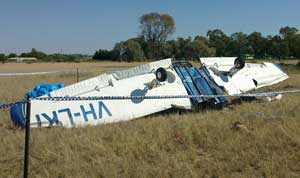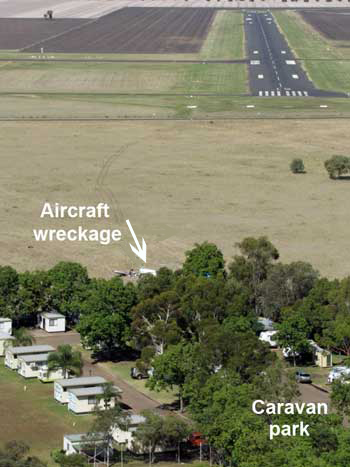By Dennis Amor
 Have
your say
Have
your say
AN AIRCRAFT which narrowly missed crashing into a NSW
caravan park at night was overloaded and the pilot lacked experience, an
official report has revealed.
Four people died and two others were critically injured when the
single-engine Piper
Saratoga swooped low over Moree's Gwydir Caravan Park in the state's
north-west, clipped trees and nosedived into a paddock on the fringe of
the park, flipping onto its roof.
Stunned tourists and residents from the 150-site caravan park, a member of
the Family Parks chain, rushed to the crash site off Blueberry Road and
helped pull two badly injured passengers from the wreckage.
A receptionist told Caravanning News shortly after the disaster
that a member of staff comforted one young survivor until emergency
services arrived.
"The 'plane was very low when it passed over our park," she said.
Three generations of a prominent NSW farming family were on the doomed
single-engined aircraft, which had taken off from Moree that morning and
was returning from Brewarrina about 350km away.
Family head Digby Boland and wife Robyn, both 77, were killed along with
pilot Phillip Jones, 63, and the Bolands' daughter, Michelle, 47.
But Mr Boland's 42-year-old son Guy and 12-year-old granddaughter Hannah
survived the crash.
The Australian Transport Safety Bureau has now published its official
report into the accident which revealed that the aircraft was
overloaded by 90kg when it crashed in darkness.
It had been originally been overloaded by about 250kg that morning because
of the number of passengers and full fuel tanks, the ATSB found.
 |
|
The doomed
aircraft rests upside down just metres from the caravan park
boundary |
"The aircraftís weight and balance charts clearly showed
that with the five passengers and full fuel, the aircraft was outside the
aircraft limits," the ATSB report said.
"The pilot had the option of limiting the number of passengers or reducing
the fuel load to ensure that the aircraft was within its design limits."
Mr Jones had taken neither option.
The ATSB also said the aircraft's centre of gravity was incorrectly
positioned towards the rear, affecting its stability.
The report found Mr Jones, who had held a pilot's licence since 1968,
misjudged his approach to the runway.
He had qualified to fly at night in 1983, but had only flown in darkness
for one hour in the year leading to the crash.
"The pilotís total night flying hours were acquired over an 18-year
period. This, in addition to the pilotís lack of night recency and time
since the last night-flying review, limited the opportunity for the pilot
to maintain proficiency and increased the risk of the misperception of the
available visual cues," the report said.
"A lack of recency would have resulted in his performance becoming more
variable over time."
This, added to a lack of visual clues such as ground lighting, meant he
misjudged the approach to the Moree runway.
"The reduced number of visual cues, combined with the pilot's lack of
night flying recency and low night flying experience, likely degraded the
pilot's performance," the report said.
The ATSB said the accident would not normally have been survivable.





